| Reviews & Columns |
|
Reviews DVD TV on DVD Blu-ray 4K UHD International DVDs In Theaters Reviews by Studio Video Games Features Collector Series DVDs Easter Egg Database Interviews DVD Talk Radio Feature Articles Columns Anime Talk DVD Savant Horror DVDs The M.O.D. Squad Art House HD Talk Silent DVD
|
DVD Talk Forum |
|
|
| Resources |
|
DVD Price Search Customer Service #'s RCE Info Links |
|
Columns
|
|
|
Off The Grid - Life On The Mesa
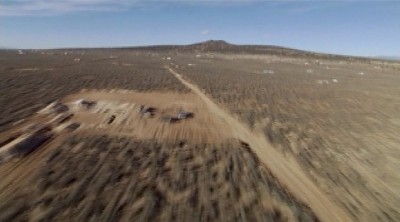
The legal status of the land this community squats on is never addressed. Since the authorities would be unlikely to tolerate a squatter community of this size on Federal or State lands, presumably, it's abandoned private property.
The arid mesa is twenty-five miles outside of the nearest town, but seems considerably further. There are no maintained roads, water lines or wells, sewers, power or phone lines, garbage collection, schools, or other services communities generally rely on. The authorities come in from time to time to make drug raids, but otherwise generally leave the squatters alone.
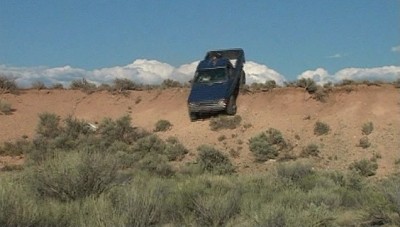
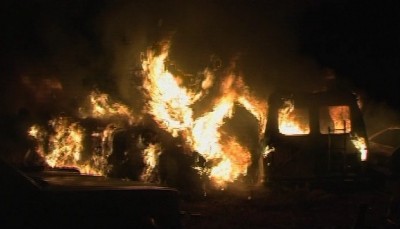
Almost nobody seems to be supporting themselves through savings or legal employment. The community makes some gestures towards self-sufficiency with a few rain barrels and solar panels, some pigs and a plot of stringy vegetables, but it appears most of the economics of the community revolve around illicit drugs, Government payments, and private charity.
The eclectic community is loosely organized around two basic rules: don't steal from your neighbor, and don't shoot your neighbor. When the first rule is broken by the Nowhere Kids, an anarchist collective of teen runaways who don't recognize private property rights, the community elders come together to decide what to do. Alternating calls for police involvement and violent self-help give way to accommodation and appeasement orchestrated by the community's senior women, know as the "Mamas", though one doubts whether this does anything more than put off a more permanent solution till a later date.
None of the anarchist Nowhere Kids agree to appear on camera, but the Stulbergs do manage to gain the trust and cooperation of a number of the mesa inhabitants who do, surprisingly, welcome the cameras into their lives. Several are Gulf War vets with physical and emotional injuries. A former second lieutenant in the 82nd Airborne Division, who goes by the nickname Maine, is suffering from untreated cancer that he attributes to destroying chemical weapon stockpiles in Iraq. Dreadie Jeff claims to be suffering from post-traumatic stress disorder from seeing too much carnage on the highway of death leading out of Kuwait. Gecko is also a vet not able to cope within the prevailing society. Though he wishes to raise his four children in a camper on the mesa, his wife has other plans.
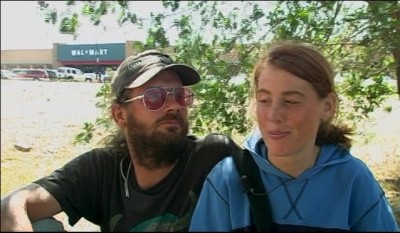
Stan, a pig farmer, and likely the oldest living resident on the mesa, is known far and wide for taking in runaways. One such teen who arrives during filming is Virginia, who initially appears open and sweet in a way that girls on the run rarely do for long. And, sure enough, the next time we see Virginia she's high on crack, panhandling outside Wal-Mart with a 35-year-old boyfriend. Shortly thereafter, her boyfriend and she are back on the mesa with a baby on the way.
The DVD
The Video:
The letterboxed 1.85:1 image suffers from severe video noise. Colors are fine, but the numerous compression artifacts and severe aliasing immediately catch the eye.
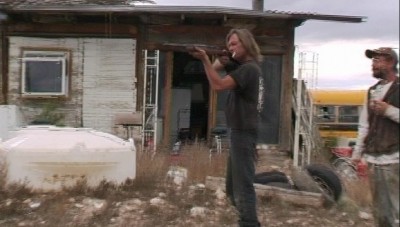
The Audio:
The 2.0 DD audio track is adequate with minimal dropouts or distortion.
There are no subtitles available on this release.
The Extras:
The extras are substantial. They include a theatrical trailer, six deleted scenes, six extended interviews with mesa residents, and a commentary track with co-directors Randy and Jeremy Stulberg and cinematographers Liz Rubin and Reed Morano. The commentary is informative and free of empty pauses, providing details on the crew's reaction to and relationship with the documentary participants.
Final Thoughts:
Though I wish filmmakers Jeremy and Randy Stulberg had spent more time addressing how the community economy truly functions, had addressed the legal status of the land, and had gotten the residents to better explain how public assistance and private charity are reconcilable with their views on personal liberty, the interviews were well done and engaging. Though some readers may choose to buy this release, given the poor video quality, most should be content to rent it.
|
| Popular Reviews |
| Sponsored Links |
|
|
| Sponsored Links |
|
|
| Release List | Reviews | Shop | Newsletter | Forum | DVD Giveaways | Blu-Ray | Advertise |
|
Copyright 2024 DVDTalk.com All Rights Reserved. Legal Info, Privacy Policy, Terms of Use,
Manage Preferences,
Your Privacy Choices | |||||||














